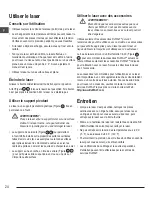
9
E
Turning the Laser On
1.
Place the laser on a smooth, flat, level surface, with the
laser facing straight ahead toward the opposing wall (0
º
position).
2.
Turn the laser ON to display the
horizontal and vertical
laser beams. Either:
•
Move the Power/Transport Lock switch to the
left to
keep the pendulum locked and display the cross beams
in manual mode (Figure
A
1
).
• Move the
Power/Transport Lock switch
to the right to
unlock the pendulum and display the cross beams in
self-leveling mode (Figure
A
3
).
3.
Check the horizontal and vertical laser beams.
• If the laser is tilted so much that it cannot self-level
(> 4°), or the laser is not level in manual mode, the laser
beams will flash.
•
If the laser beams flash,
the laser is not level (or plumb)
and should NOT BE USED for determining or marking
level or plumb. Try repositioning the laser on a level
surface.
4.
If ANY of the following statements are TRUE, continue with
the instructions for
Checking Laser Accuracy BEFORE
USING THE LASER for a project.
• This is the first time you are using the laser (in case the
laser was exposed to extreme temperatures).
• The laser has not been checked for accuracy in
a while.
•
The laser may have been
dropped.
Checking Laser Accuracy
The laser tools are sealed and calibrated at the factory. It
is
recommended that you perform an accuracy check
prior
to using the laser for the first time
(in case the laser was
exposed to extreme temperatures)
and then regularly to
ensure the accuracy of your work. When performing any of
the accuracy checks listed in this manual, follow these
guidelines:
•
Use the largest area/distance possible,
closest to the
operating distance
. The greater the area/distance, the
easier to measure the accuracy of the laser.
•
Place the laser on a
smooth, flat, stable surface that is
level in both directions.
• Mark the center of the laser beam.
Horizontal Beam - Scan Direction
Checking the horizontal scan calibration of the laser requires
two walls at least 30
′ (
9m) apart. It is important to conduct
a calibration check using a distance no shorter than the distance
of the applications for which the tool will be used.
1.
Place the back of the laser against a wall and facing straight
ahead toward the opposing wall (Figure
D
1
).
2.
Move the
Power/Transport Lock switch to the right
(Figure
A
3
) to turn
the laser ON in self-leveling mode and display
the horizontal and vertical beams.
3.
Turn the laser 45º
counter-clockwise so that the right-most
end of the laser line is displayed on the wall
.
4.
Mark
a
on the center of the beam on the wall.
5.
Turn the laser 90º
clockwise so that the left-most end of
the laser line is displayed near
a
(Figure
D
2
).
6.
Mark
b
on the center of the beam on the wall.
7.
Measure the vertical distance between
a
and
b
.
8.
If your measurement is greater than the
Allowable
Distance Between
a
and
b
for the corresponding
Distance Between Walls
in the following table, the laser
must be serviced at an authorized service center.
Distance
Between Walls
Allowable Distance
Between
a
and
b
30
′
(9m)
15/32” (12mm)
40
′
(12m)
9/16” (14.4mm)
50
′
(15m)
23/32” (18mm)
Horizontal Beam - Pitch Direction
Checking the horizontal pitch calibration of the laser requires
a single wall at least 30
′
(9m) long. It is important to conduct
a calibration check using a distance no shorter than the distance
of the applications for which the tool will be used.
1.
Place the laser against the end of the wall
(Figure
E
1
).
2.
Move the
Power/Transport Lock switch to the right
(Figure
A
3
) to turn
the laser ON in self-leveling mode and display
the horizontal and vertical beams.
3.
At least 30
′
(9m) apart along the laser beam, mark
a
and
b
.
Summary of Contents for DW08802
Page 2: ...1 2 4º _ Figures 2 A B 1 4 20 1 2 3 3 ...
Page 3: ...1 2 3 C 180º 3 4 ...
Page 4: ...Figures 4 D 1 2 45 90 a b a 30 9m _ ...
Page 5: ...5 1 2 3 E a b c a b b a b 30 9m _ ...
Page 6: ...Figures 6 F a 5 1 5 m a b 1 2 ...
Page 33: ...33 Notes ...










































